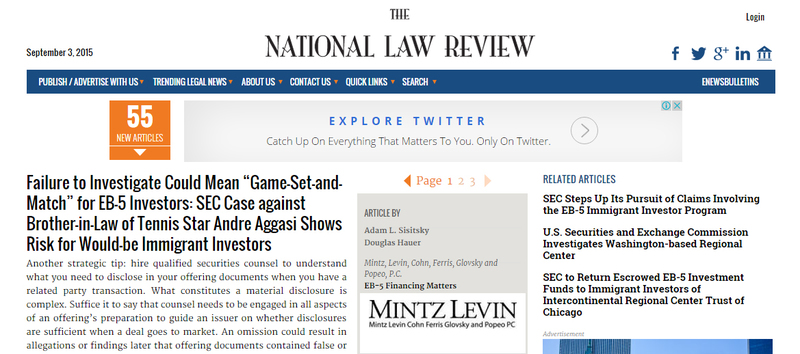Failure to Investigate Could Mean “Game-Set-and-Match” for EB-5 Investors: SEC Case against Brother-in-Law of Tennis Star Andre Aggasi Shows Risk for Would-be Immigrant Investors

The U.S. Securities and Exchange Commission (SEC) filed a civil fraud suit against Lobsang Dargey, a Bellevue, Washington-based real estate developer and alleged fraudster, who also happens to be a brother-in-law of tennis star Andre Agassi. Dargey had ventured into the EB-5 Program as a developer and regional center owner, securing designation by United States Citizenship and Immigration Services (USCIS) for two regional centers, Path America SnoCo and Path America KingCo. The complaint is relevant to both investors and regional centers in the EB-5 industry, as well as to lawyers advising issuers in EB-5 offerings.
Dargey has now landed in hot water for engaging in fraud and deceit in the EB-5 offering process, as well as for using related Path America companies to siphon investor funds into his own pockets. The SEC has charged him for making false and misleading statements in EB-5 offering documents, alleging that since 2012 Dargey has exploited the EB-5 Program to defraud investors seeking investment returns and a lawful path to U.S. permanent residency. Among the allegations is misappropriation of $17.6 million in investor funds.
Summary of the SEC’s Complaint
The SEC alleges that Dargey, through his solely owned and controlled entity Path America, LLC, had diverted to himself and for his own personal benefit millions of dollars he had raised from Chinese nationals for EB-5 projects sponsored by Path America-owned regional centers. Path America had raised money for projects including the proposed Potala Farmers Market (a hotel, apartment and retail project in Everett, Washington), as well as the Potala Tower (a proposed 440 foot, 40-story hotel-and-apartment tower) in Seattle. Path America serves as the managing member of both USCIS designated regional centers and had unfettered control over the entire EB-5 investment process for the offerings.
In bringing the suit, the SEC also obtained a temporary asset freeze against Dargey and numerous related corporate defendants to prevent Dargey from pursuing his recently-announced plans to raise an additional $95 million from investors. According to the SEC, Dargey spent some of the siphoned funds on a $2.5 million home in Bellevue as well as at various gambling casinos. He also diverted EB-5 funds to projects that were unrelated to those disclosed in his offering documents to investors, meaning that the green card petitions pursued by EB-5 investors would be infirm.
A Path to America Fraught with Securities Fraud
The Path America case raises questions about investments buttressed by stories that seem to-good-to-be-true: Dargey left his Tibetan homeland and goat-herding profession in 1997 to pursue opportunities in the United States, as a house painter though he didn’t speak a word of English, and later rose to become a successful real estate developer. Dargey’s personal biography was almost certainly a lure to investors, and he conditioned the EB-5 market with his life story. In the media, Dargey touted his personal journey from Buddhism to capitalism, creating a background narrative for his real estate ventures and perceived success. Dargey’s story should caution investors to thoroughly examine the organizations backing the EB-5 projects in which they invest despite any personal affinity or connectivity with the background of a project promoter. Although the SEC has not directly asserted that this case involved affinity fraud, it is clear that Dargey targeted Chinese investors who may have felt an affinity with him.
This is a common tactic employed by a schemer in affinity fraud.
If true, the allegations levied by the SEC make a strong case against Dargey for securities fraud, which is at the heart of the complaint. An element of any claim of securities fraud is the defendant’s state of mind, specifically, whether the defendant acted with “scienter” or “fraudulent intent.” Frequently, aggrieved investors in actions to recover their investment losses have tried to establish scienter by pointing to a defendant’s “motive and opportunity” to commit fraud. The Dargey case illustrates how control of numerous related entities involved in this EB-5 financing program may give a defendant ample “opportunity” to siphon off investor funds and commit fraud, while keeping investors in the dark about material changes to how he used investor funds. Nine different corporate entities were named as defendants in this case, and, according to the SEC’s Complaint, Dargey maintained control over all of them to such a degree that he was able to repeatedly transfer funds between the entities and into accounts that he controlled, eventually withdrawing large sums of cash which he used to gamble and purchase real estate. A quick records search on the State of Washington’s Secretary of State’s corporate records database reveals that Dargey (or a member of his executive team listed on his company website) is in fact the registered agent for each of these companies.
The Dargey case serves as a reminder to investors in EB-5 regional center projects (or any other investment vehicle) to be thorough and circumspect in evaluating the organizational structure of any enterprises set up to achieve the advertised goals, particularly where numerous inter-related projects are involved and particularly where the entire enterprise appears to be under the control of just one individual. Unlike Mr. Dargey’s rags-to-riches success story, some opportunities are just too good to be true.
Related Party Transactions Can Be Traps for Unwary EB-5 Regional Centers and Issuers
Regional centers and issuers of EB-5 investments should also consider carefully the lessons in Dargey’s case about potential SEC scrutiny of related party transactions.
USCIS designated regional centers that handle investor funds and that facilitate offerings also need to be cautious, even when they think they are doing everything properly. The SEC is showing an increased interest in the EB-5 Program, and this interest appears to be here to stay.
One hot topic is related party transactions that, when improperly concealed, keep investors in the dark about the economic relationships among multiple related entities in a deal. Disclosures about related party transactions should not be buried in a Private Placement Memo (PPM), but should be identifiable and written in clear language. If a regional center, developer and general partner are essentially one and the same party in your deal, your offering could be subject to a higher level of scrutiny later particularly with respect to whether all material disclosures were properly presented in offering documents. Related party transactions require careful and robust disclosures so that investors can evaluate the substance of potential conflicts. Such disclosures belong to the total mix of information that a reasonable investor would need to know in order to make an investment decision. The omission of such disclosures can lead to litigation later with the SEC and investors.
While transparency to investors is paramount, so too is fairness. If you are conducting an offering with related party transactions, ensure that you have a commercially reasonable basis for the economics of your deal. Also have objective controls on how investor funds are managed and spent. One practice tip is to engage an auditor that provides annual or even semi-annual or quarterly reports to investors. Even regional center owners or managers who don’t engage in criminal or egregious conduct can find the SEC knocking at the door and alleging fraud when material facts in a deal are not disclosed to investors, or when there are questions about how investor funds were handled.
Another strategic tip: hire qualified securities counsel to understand what you need to disclose in your offering documents when you have a related party transaction. What constitutes a material disclosure is complex. Suffice it to say that counsel needs to be engaged in all aspects of an offering’s preparation to guide an issuer on whether disclosures are sufficient when a deal goes to market. An omission could result in allegations or findings later that offering documents contained false or misleading statements. An omission of a material fact about related party transactions can have dire consequences including rescission in favor of investors, an SEC finding of securities fraud under Section 10(b) of the 1933 Securities Act and exposure under Rule 10b-5, one of the most important rules promulgated by the SEC with respect to securities fraud. Allegations by the SEC that an issuer or regional center has made false and misleading statements in an offering process can lead to assets being frozen and costly civil fraud litigation, particularly where the SEC can show opportunity to commit fraud through related party dealings.
How Can Regional Centers and Issuers of EB-5 Securities Mitigate Litigation Risks?
Every EB-5 regional center or issuer should consider adding a securities litigator to the offering team before introducing a deal into the marketplace. In the current climate, guidance on risk mitigation in an offering is critical. Having counsel involved early on during drafting sessions of an offering is an effective way to understand your disclosure obligations as you prepare a PPM. A securities litigator following the lifecycle of your offering – from inception of a business plan to closing of a deal – can serve as an excellent advisor to issuers in preventing problems and miscommunications with investors and government agencies. In the current climate, risk mitigation is an important component of EB-5 regional center business planning and operations.
Conclusion
The SEC is the ultimate referee in an EB-5 deal. Playing ball by the rules matters, especially when it comes to ensuring that material facts are disclosed to investors. Disclosures are the “sweetspot” of a PPM. A PPM without the right disclosures is about as effective as tennis racquet with no sweetspot. You’ve lost the match before the first serve.
If SEC litigation increases in the EB-5 realm, then we expect that otherwise lawabiding and compliant regional centers could be inadvertently swept up into costly litigation. This will be true even with regional centers who make a good faith effort to comply with the law. An SEC complaint against your regional center could seriously impede your ability to do business, even if you have the law and facts in your court. Therefore, now’s the time to add securities litigation counsel to your EB-5 team, if you haven’t done so already. Securities litigation counsel experienced in the purchase and sale of securities, the Foreign Corrupt Practices Act (FCPA), disputes with the SEC over what constitutes materiality in an offering, and other relevant areas can help you mitigate risk, protect investors and raise funds as you intended.
Mentions
- U.S. Citizenship and Immigration Services
- UNITED STATES SECURITIES AND EXCHANGE COMMISSION
- DARGEY
- Lobsang Dargey
- Path America Sonoco
- Path America
- Potala Tower Seattle
- Potala Farmers' Market
States
- Washington
Videos





Subscribe for News
Site Digest
Join Professionals on EB5Projects.com →
Securities Disclaimer
This website is for informational purposes only and does not constitute an offer or solicitation to sell shares or securities. Any such offer or solicitation will be made only by means of an investment's confidential Offering Memorandum and in accordance with the terms of all applicable securities and other laws. This website does not constitute or form part of, and should not be construed as, any offer for sale or subscription of, or any invitation to offer to buy or subscribe for, any securities, nor should it or any part of it form the basis of, or be relied on in any connection with, any contract or commitment whatsoever. EB5Projects.com LLC and its affiliates expressly disclaim any and all responsibility for any direct or consequential loss or damage of any kind whatsoever arising directly or indirectly from: (i) reliance on any information contained in the website, (ii) any error, omission or inaccuracy in any such information or (iii) any action resulting therefrom.


